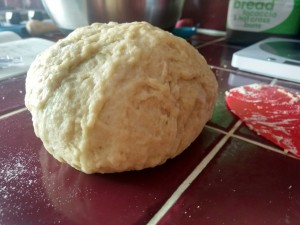This is my first venture into a whole new culture of baking traditions. What’s unusual about this post is that, until today, I had never tried this bread, originally from Cyprus and Greece. However, it has been so highly spoken of on many occasions that, of course, I had to give it a try. I come from a family of bread-lovers, after all.
First off, I found a recipe on Youtube with a finished product that resembled what I wanted to make (loaves, not rings, which are also a thing). Even though the recipe is written in the video description, one of the measurement terms was confusing. It was only through careful scrutiny of the video that I realised that ‘glasses’ meant ‘cups’. Duh me.
However that recipe yields 3 loaves, which is way too much for myself. So I halved the recipe and also converted it to the metric system for future convenience.

A note on two of the spices, mastic and mahlepi: they can be found in Turkish as well Greek shops.

I myself had to trek all the way up to west London in this horrible heat wave to find 2 tiny sachets of the stuffs. On the bright side, they also had the actual koulouri loaves and loads of cheese varieties, so naturally I bought some to make it worth my trip.

Ok, here’s the recipe (again, half the quantities of the video’s):
2 cups (282g) strong bread flour
1 1/4 cup (188g) plain flour
7g dried yeast (one sachet)
88ml olive oil
2.5 grains mahlepi (just make it 3)
2.5 grains mastic (just make it 3)
1/2 tsp sugar (to grind the spices with, total weight of spices and sugar was about 3g)
1/4 tsp baking powder
pinch of salt
1 cup (225ml) lukewarm milk (I used whole)
For the glaze:
1 egg yolk beaten with 2 tbsp of milk
sesame seeds
Method
The actual bread-making process is pretty much the same as all bread. Combine the dry ingredients (make sure not to forget the baking powder, like I did, which I added when I had already started adding the milk). Add the oil and rub into the flour until it resembles bread crumbs (similar to making shortcrust pastry).

Add half of the milk and knead. Add the rest of the milk and knead until it becomes elastic.

I might have overkneaded my dough because it didn’t resemble the nice smooth dough in the video, but it rose ok. After an hour it had nearly doubled in size, so I turned it out unto the counter and shaped it a little like Stavros did in the video. I placed it on the prepared baking tray (baking paper + sesame seeds). Using my sharpest knife I cut slits into it and covered it with a tea towel to prove for about 20 minutes.

I then used a pastry brush to glaze the loaf with the egg yolk and milk which had been beaten together. Last were the sesame seeds on top.

Bake at 180C for about 30min or until golden brown. It should sound hollow when tapped on the bottom.

On analyzing my loaf, I could probably have let the dough rise a bit longer the first time. The texture is a bit strange, not that of bread (light and fluffy) but of cake (denser and moist). According to the brief research I did online, the texture of koulouri is cake-like but in the pictures and videos I’ve seen it looks more bread-like so….who knows what’s right?
I did come across another video for making koulouri loaves with a process very similar to the one I followed, except the milk is added first and the oil last, resembling more typical bread-making. Since I already have the spices I need, I could definitely start a koulouri bread lab. Now, what will I do with all this bread?

